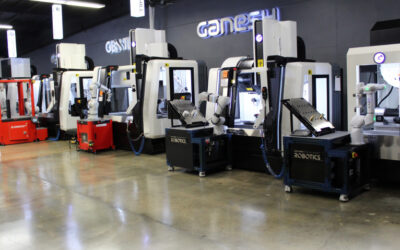With the goal of providing comprehensive market intelligence for spare parts offerings, MARKT-PILOT has modernized the pricing of replacement parts with the aid of its ground-breaking software, PRICE-RADAR, while fostering sustainable growth in the parts business. By aggregating data from more than 10,000 industrial sources and creating market transparency for each spare part, MARKT-PILOT’s solution can increase an organization’s part revenue by an average of 20 percent after applying a market-based pricing strategy.
Founded in Germany in 2020 to help machine manufacturers grow their spare parts business while boosting sales volume and revenue, the company’s customer-focused approach and innovative thinking address the mandate that it’s impossible to accurately price products without using a market and data-driven approach.
“Historically, all companies used to do cost-plus pricing for their spare parts, the most common approach to parts pricing because it’s very simple,” says Tim Geyer, Head of North America. However, in today’s digital environment, the cost-plus pricing approach doesn’t work anymore, he adds, and one of the reasons is there are many third-party competitors offering the same parts to end users.
“Competitors are already using digital capabilities to update prices and to expand offerings, and OEMs don’t.”
Manufacturers also have a very complex parts portfolio, making it impossible to manually keep track of what they should be charging for a part. By only using cost-plus approaches, companies are going to miss the mark for more than 90 percent of their parts. While manufacturers do source parts from different suppliers at varying discounts, if they use a cost-plus approach for all their parts, they unwittingly overprice or underprice many of their parts.
“Parts are extremely important and a large driver of profit and revenue,” says Geyer. “But OEMs now have a very strong competitive environment, and their pricing strategies simply don’t work in that environment anymore.”
“There is a difference, however, when it comes to manufactured items and commercial items,” adds Alex Morbe, CEO.
“The cost-plus logic works pretty well with the manufactured items since they have all the data, drawings, design, and the IP in-house,” he says. “This is all they need to get pricing out there and they don’t really compete against anyone… However, this is different with all the commercial items.” With this segment of parts, it’s very important to have market data, which is where MARKT-PILOT comes in.
“Quick, intelligent access to competitive market information such as lead times and parts pricing wasn’t possible two years ago, and we are exclusive in that way,” says Morbe. “There’s no one else who can do the same thing that we do, while being focused on sustainable revenue growth.”
MARKT-PILOT is an advocate of market-based parts pricing, believing it’s the best way for an OEM to price purchased parts and the best way to maximize customer loyalty, increase revenue, and increase profit margins, adds Geyer. In short, without manual effort, OEMs can find the perfect sales price for every single part they’re selling, while ensuring they’re in line with the market, have competitive offerings, and still charge what customers are willing to pay.
This all started when the company’s founder Tobias Rieker, while working as a pricing analyst for an OEM, was tasked with comparing prices against third-party competitors. Customers complained about expensive parts; meanwhile, the company owner felt they were undercharging. Rieker’s analysis revealed they were leaving money on the table for more than 70 percent of their parts, and believed there must be a sustainable way to gather market data for parts at scale with less manual effort.
“He spent a lot of time finding that information,” says Geyer. “When he finally got market data for a couple hundred parts, he randomly checked some parts again, and found out all of the prices were outdated already, because they’d changed in the meantime.”
The main reason for the company’s success is realizing that on average, OEMs price 21.7 percent of parts below market value, says Geyer.
“Their competitors are charging more for these parts than the OEM, and obviously an OEM should never be the cheapest play on the market because they’ve invested so much in branding and the customer relationship already. So, they should definitely be charging more than third-party vendors.”
When it comes to exclusive parts—51.9 percent—an OEM typically has no or very limited competition, meaning customers have a hard time finding alternative vendors for these parts.
“Even though it’s purchased parts, there are many reasons why it could be exclusive to the OEM,” Geyer says. “And for these parts, there’s essentially no competition. They could be charging much more, resulting in the OEM leaving money on the table for these parts as well.”
Market-based pricing, he adds, benefits OEMs as they can increase prices with confidence for underpriced parts, capitalize on exclusivity for parts where they have limited or no competition, and boost sales volumes by intelligently reducing prices for some parts where they have charged too much historically.
The system is working. Initially a small German startup, MARKT-PILOT expanded to the North American market in 2021 where it has helped 150 OEMs increase their spare part revenue and customer loyalty. Key results include increasing parts revenue by more than 200 million USD in total, averaging a 20 percent increase in parts revenue after implementing a pricing strategy fueled by PRICE-RADAR’s market data.
“It’s the reason we were so successful, because it’s a very clear business case,” says Geyer. “When our customers first start working with us, we provide them with an analysis where we look at their current portfolio, how much money they make with purchase parts right now, typical profit margin, and more. We give them a very valid estimate, backed up by strong data, of what we know is possible for them to achieve from a top line revenue and ROI perspective.”
Although the topic is still fairly new, the industry has realized market data is imperative for future success, particularly in equipment manufacturing sectors including agriculture, mining, construction, tool, packaging, and plastics processing machinery, where MARKT-PILOT focuses on providing the most accurate data possible.
“It’s very challenging because the data quality in manufacturing isn’t always the best out there,” says Geyer. “We created a technology tailored to work for the machinery industry, and that can really cope with both the data quality and the processes within the industry, instead of being generic and not providing true value to our customer. Our approach is very targeted in that sense.”
MARKT-PILOT’s “secret sauce” is providing the most accurate market data for parts by having access to more than 10,000 data sources globally, including relevant e-commerce platforms, web shops, and marketplaces where a customer can look up a part and purchase it from an online vendor. The company also gathers data from more traditional channels, including parts manufacturers, distributors, dealers, and offline vendors, collecting information on prices, availability, and lead time for every single part that customers want analyzed. Within one dashboard, they can see exactly which parts they’re currently underpricing, which they are overpricing, and which they are the exclusive vendor for.
“We tell them exactly what we recommend they should be charging for these parts as well,” says Geyer. “They see the market prices and we help them find the perfect sales price to improve their financial results, and at the same time make sure that customer retention and customer loyalty is maximized.”
When an OEM first starts working with MARKT-PILOT, they upload a list of their most important parts with pricing, and within three to four weeks, they receive an initial full-market benchmark, where they might find they’re underpricing 3,500 parts and overpricing 2,000, for example. MARKT-PILOT’s experienced customer success managers then examine the information and provide specific recommendations on how to change prices and communicate the changes to customers.
Helping customers realize the competition for parts out there, and the need for a better visibility of the market without sacrificing resources means it’s vital to provide automated solutions. “We make sure our customers’ team can really focus on what matters, and that’s always serving end users, coming up with new strategies, and increasing customer loyalty, rather than focusing on manual tasks, like comparing prices on the internet,” says Geyer.
And that pricing is incredibly difficult right now, with the cost surges going on due to inflation and supply chain issues, he adds. “The best way to cope with that complexity is simply to integrate market data into your pricing strategy, rather than trying to guess or come up with elaborate, handmade strategies yourself.”
It’s always best to rely on what the market will bear, and that’s only discernible by having high-quality, accurate market data available at scale for your parts portfolio, which is exactly what MARKT-PILOT provides.
“What sets us apart is the quality, as we know our customers rely on our data,” says Morbe. “Our main goal is to provide this strong data, so we want to make sure that everyone who works with our data can rely on it. This is where we have our AI in place, and we’re highly focused and specialized in validating results. We make sure our customers only use confirmed data.”
This is also something put in place at an early stage, as the company realizes how important and how unreliable market data can be. “If you just Google a bike, you will also find cars, socks, everything,” says Morbe. “We want to make sure our customers don’t see the results they don’t need.”
The company’s AI data engineering team in Germany developed and continues to build PRICE-RADAR in-house, ensuring no technology is outsourced, unlike other solutions in the market. MARKT-PILOT works exclusively with OEMs in the machinery industry, another key differentiator compared to other pricing software.
“We live and breathe their challenges,” says Geyer. “We’re 100 percent focused on OEMs.”
That dedication to customer service is appreciated. “When they start working with us, it’s an eye opener for them, because they realize they don’t need consultants to come in and help achieve results with the data they now have. It’s much easier to understand and use in daily business, thus more cost-efficient,” says Geyer.
And while other pricing projects usually yield a return of maybe two or three percent, MARKT-PILOT looks at typical revenue and margin increases of up to 20 percent, a “game changer,” shares Morbe.
“We’re the enabler of a market-based parts pricing strategy, and we’re a big advocate of that strategy versus the more traditional strategies,” Geyer adds. “And no, there’s no other provider out there that can help an OEM adopt this market-based pricing strategy at scale.”













